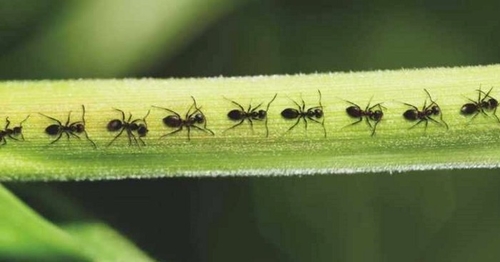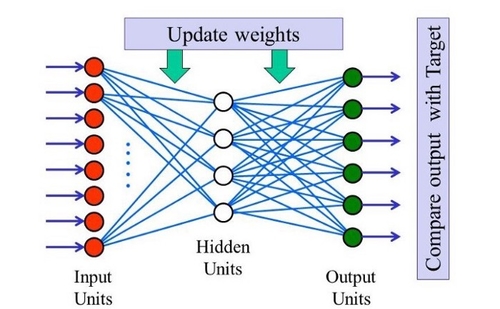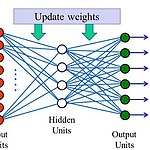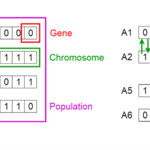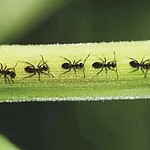Swarm/collective intelligence
Swarm intelligence is group of optimization algorithms that takes inspiration from how collective intelligence work. Some of the very effective results of evolution are insects like bees, termites and ants. While individually any of these insects may not appear to be very intelligent, they cooperate and work as a group to find solutions to complex problems like finding an optimal route to the source of food.
Consider how ant colonies find the best route to the source of food. Ants roam around until one of them has found a source of food. The ant which found the food source leaves a trace of a chemical called pheromone while coming back to its colony. This pheromone trace works as a guiding mechanism for other wandering ants using which they reach to the same food source. These ants also leave a trace of pheromone while returning. As a result, the pheromone trail becomes stronger and stronger with more ants using the same path to reach to the food source and return. Eventually all ants start following the same path to reach to the food source.
An example of Swarm Intelligence include Ant-based routing. Ant-based routing is a technique in which multiple paths are set up between the source and destination of a data session or a graph. The aim of AI is then to find the best path by testing existing paths and exploring new ones.
Genetic Algorithms
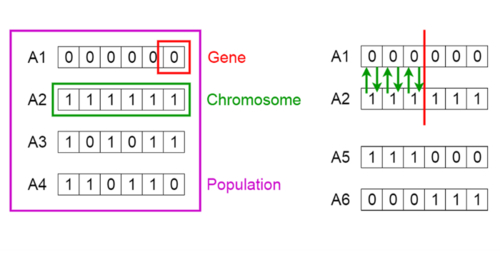
Genetic algorithms are optimization algorithms that takes inspiration from evolution in nature. Nature optimizes the fitness of a species over succeeding generations through propagation of genes. Similarly genetic algorithms work by evolving successive generations of genomes which get progressively more and more fit over the generations. Just like nature has them for evolution, the key processes involved in genetic algorithms are Selection, Crossover and Mutation.
- An initial population of genomes is randomly generated. The process of Selection involves testing the fitness of genomes using a fitness function. All the weak genomes (w.r.t. the fitness function of choice) are discarded and the strong genomes gets to the next stage called crossover.
- Crossover is analogous to reproduction in nature. It results in generation of two new genomes from two existing ones. Crossover starts with selecting two fit genomes and choosing a random position in the genome strings. This random position is called as crossover point and the parts of genome strings are swapped at this point. The resulting genomes have a piece of their genetic code from their parents.
- Sometimes, if all genomes in a generation are very similar, not much improvement is seen in the next generation. Mutation helps in these scenarios. In mutation, random parts of a genome are changed to result in a new genome that is drastically different from the rest of genomes in that generation. Like nature, mutation is used rarely and the results can’t be predicted.
Genetic algorithms find application in for example optimization problems. The goal of the optimization problem technique is simply to find the best solution from all possible solutions. The more data the AI has, the more assumptions it can make and thus the bigger the chance that it will find better solutions .
Artificial neural networks
Artificial Neural Networks (ANNs) take their inspiration from how brain functions. Just like the human brain, neural networks also make use of neurons, axons, synapses and dendrites to transfer signal from the input layer of the network to the output layer. Neurons can be considered as simple computing cells and are fundamental to the operation of ANNs. ANNs use a large interconnection of neurons for optimal performance. Axons are the transmission lines or the nerves through which the signal travels between the neurons. Synapses are the nerve endings and Dendrites are the receptive zones of the neurons.
The key function of a neuron is to apply weights to all the inputs signals received from other neurons, add them and apply a bias and an activation function to limit the amplitude of the output. Once the signal travels through the network and reaches to the output layer, it is compared with the desired output using a cost function and an error signal is fed back to the network. The network then adjusts the weights applied to the signals and re-transmits an updated signal towards the output layer. This process continues until the error gets reduced to acceptable limits. Once this is done, the network training completes and it becomes ready to make predictions on the unseen data.
A large number of ANN variants have been developed with specific use cases. For example, Convolution Neural Networks (CNNs) take inspiration from visual cortex and are primarily used for image classification. Image classification involves teaching an Artificial Intelligence how to detect objects in an image based on their unique properties. An example of image classification is an AI that detects how likely an object in an image is to be an apple, orange or pear.
Time
The natural world has always designed intelligent systems. Everywhere you look, the natural world bursts with examples of complex adaptive systems. However, nature has a significant advantage on its side: time. The majority of these systems are the result of years and years of evolution. Years during which they went from one configuration to the next until they found the best way to solve the task. Technology does not have the luxury of perfecting a solution over millions of years nor can we afford catastrophes. With all their differences, nature and technology should not be excluding each other. We should pay close attention to the natural world. Start by finding out if a biological system has not already solved the problem. If it has, then there is no point in reinventing the wheel, extract the fundamental principles and methods and transfer them to the problem we are trying to solve. Nature is a source of inspiration, while technology is the engine for creation
Source:
Rastogi, N. 2019. AI - Taking inspiration from nature. Firing Neurons, Medium.
Dacian Consulting - The Natural World Helps Design Intelligent Systems
Computer Vision & Image Classification in AI. Study.
Rohrer, B. How optimization for machien learning works.
- Di Caro G., Ducatelle F., Gambardella L.M. (2004) AntHocNet: An Ant-Based Hybrid Routing Algorithm for Mobile Ad Hoc Networks. In: Yao X. et al. (eds) Parallel Problem Solving from Nature - PPSN VIII. PPSN 2004. Lecture Notes in Computer Science, vol 3242. Springer, Berlin, Heidelberg. https://doi.org/10.1007/978-3-540-30217-9_47]
